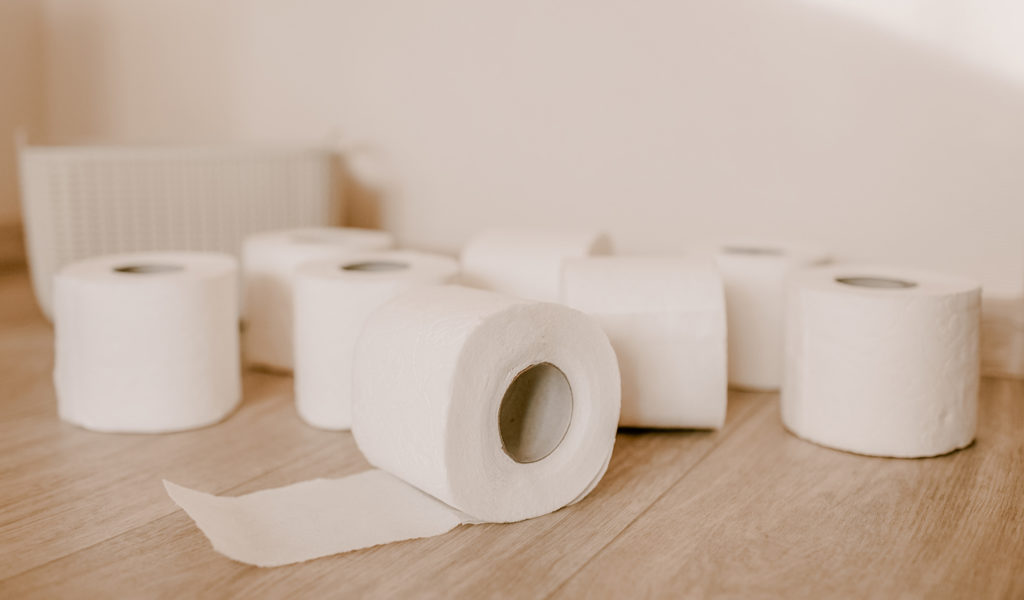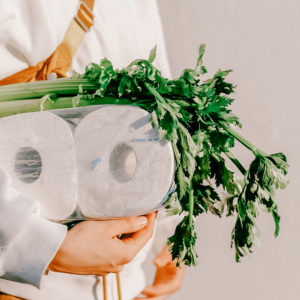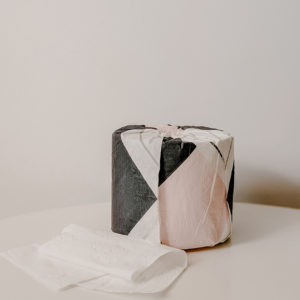While we’ve come to think of certain everyday essentials as just that, the truth is that there are zero-waste alternatives to many of the mainstays of domestic life, and toilet paper is a case in point.
The average American goes through 141 rolls of toilet paper a year without realizing that each one contributes to the ongoing harvesting of a virgin raw materials—trees. In fact, 15% of all deforestation is accounted for by toilet paper manufacture.
On top of this, if you shop at the supermarket, toilet paper usually comes wrapped in plastic, which creates an additional waste stream on top of that paper, not to mention waste created during the manufacture of the plastic in the first place.
So, is unrelenting deforestation really the only way to keep ourselves clean when going to the bathroom? Or is there a zero-waste path out of the woods?
Can Toilet Paper Really Be Zero Waste?
If you’re wondering if toilet paper can really be zero waste, the answer is a qualified yes. As we know, the concept of zero waste is least helpful when applied in absolutist terms. The manufacture and distribution of any product will inevitably have some trace environmental impact, however small.
Zero-waste toilet paper can mean paper made from post-consumer recycled materials or sustainable raw materials like bamboo, but of course even these products have some impact on the environment and are eventually flushed away.
Going a step further, applying a zero-waste approach to toilet paper can also mean cutting it out altogether. The humble bidet has transcended civilizations and is commonplace in many countries around the world today. Is the solution that simple? Well, whether you use a bidet or you’d rather be without, here we explore some of the best zero-waste toilet paper solutions.
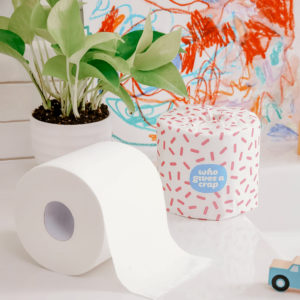
Source: us.whogivesacrap.org
Who Gives A Crap — Recycled Toilet Paper
Every day, 27,000 trees are cut down to manufacture toilet paper. So, the people behind Who Gives A Crap decided to leave the forests intact and come up with something different. Rolls are made from 100% recycled materials—mostly waste paper retrieved from offices or schools near to their manufacturing facilities. Packaging is also made of recycled paper and stands up to zero waste scrutiny.
Although the rolls are individually wrapped, don’t be fooled into thinking this is an excessive branding exercise; the same amount of paper is used as in the case of a stronger and thicker paper needed to hold 6 rolls together.
Free, carbon neutralized shipping when spending over $25 incentivises the customer to buy in bulk – a tenet of zero waste living. And if you’re already anxious about your posterior comfort, rest assured that you can take advantage of the company’s 30-day full refund program if you’re not happy.
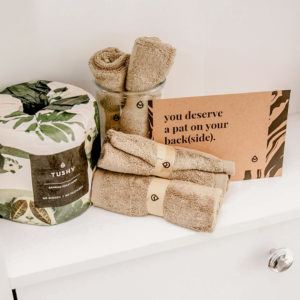
Source: instagram.com
Tushy Sustainable — Bamboo Toilet Paper
Tushy is a young company whose TP is worth getting your hands on. The environmental credentials of bamboo are already well documented, and it absorbs more CO2 than equivalent plants and grows extremely fast. This means it’s pretty close to an infinite resource.
Tushy also tells us that a roll of their bamboo toilet paper requires only 0.59 gallons of water to make, compared to 37 gallons for a conventional equivalent. The elegant illustrations adorning the recycled paper wrapping offer a more refined aesthetic than Who Gives A Crap, which may suit some bathrooms better.
Its worth remembering that Tushy toilet paper only ships in bulk packs of 36 rolls for the price of $69, although a discount lies in wait if you take a subscription. Free delivery follows from second order onwards.
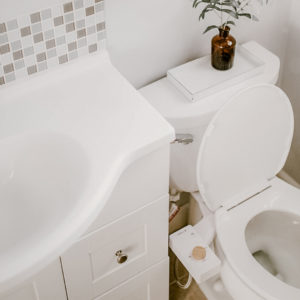
Source: instagram.com
Bidet Attachment
Some say it is time we caught up with other cultures and succumbed to the comforts, hygiene, and environmental boons of the bidet. It’s impossible to argue with the cleanliness that comes with an old-fashioned water wash. And you can rest assured that the bidet has been well and truly ushered into the 21st century in a range of attachable toilet seats with subtle directional sprayers.
Tushy comes in at the top of the list again with their range of bidet attachments ranging from basic to luxury. The clincher is that this doesn’t mean buying a new toilet but attaching a new seat onto your existing model in around 10 minutes.
Although you may be able to cut out toilet paper entirely (more on that decision below) you are of course pivoting to another source of energy by pumping additional water into your homes to wash with. Still, the pint of water needed for Tushy’s bidet is heavily outweighed by the 37 gallons per toilet roll we mentioned above.
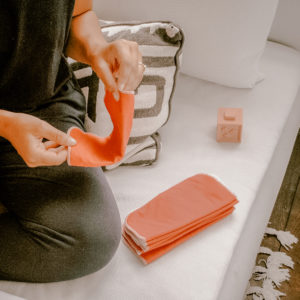
Source: shop.zerowaste.com
Reusable Cloth
Reusable squares of cloth, often dubbed ‘family cloths’, are perhaps a bridge too far for some people, however, they can be used instead of toilet paper and kept in a wet bag to be washed in the machine and reused.
A zero-waste family cloth bundle could be made at home from old scraps of clothing or towels; it’s simply two or more squares of material sewn together. There are a number of handmade options online, similar to a reusable baby cloth.
These cloths come into their own for most people as a post-bidet dryer which can be easily machine washed without the same level of ick-factor.
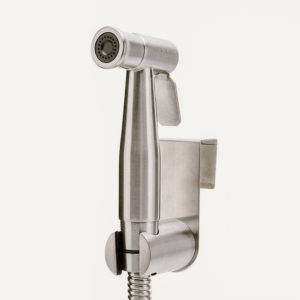
Source: purrfectzone.com
Handheld Bidet Sprayer
You’ll find these handy sprayers neatly adjoined to toilets throughout mainland Europe and beyond, but less so in the US. They connect to your water supply and function just like a mini shower with an adjustable pressure head held in the hand. It’s the convenience and hygiene of a bidet but with a little more wrist control. Our recommended brands are Brondell and Purrfectzone.
Toto Portable Bidet
For those without the budget or the courage for a new bidet toilet seat attachment, there are these genius little handheld sprayers to do the same job. Chief among them is toilet trailblazer Toto’s portable Washlet.

Source: totousa.com
Battery powered and held easily in the hand, this smart product achieves the same level of cleanliness as a bidet attachment without the installation or disposal of an existing toilet seat.
While not cheap, if you opted for this as your main method of cleaning up (e.g, over the zero-waste toilet paper mentioned above) throughout the year, you’d soon be saving money in a household of numerous people. Even if you’re not ready to deploy the family cloth to dry off post-bidet, stick with bamboo paper and you’ll still need far less paper than you would otherwise.
Now that we’ve highlighted the best zero-waste toilet papers from the rest and pointed out a few non-paper solutions, you’re ready to go zero-waste in the bathroom. What’s for sure is that any combination of the above methods is already better than deforestation plus wrapping the resultant product in plastic.
The price of a recycled paper or bamboo roll comes out as comparable to a mid-range supermarket equivalent, which isn’t out of most household budgets. Although it is true that there will always be cheaper solutions out there, the net environmental gains are so great they can hardly be ignored.
Just remember, if you come across a new sustainable toilet paper in your local shop, make sure to assess its zero-waste credentials before buying. Avoid anything packaged in plastic and if you can’t, be sure to recycle it afterwards. Buy in bulk where possible, especially when buying online, and avoid bleached paper even if it is made from post-consumer waste or bamboo.
In the meantime you can browse our blog for a host of tips and guidelines for going zero waste in other areas of your life.

